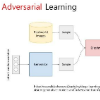Complementary item recommendations are a ubiquitous feature of modern e-commerce sites. Such recommendations are highly effective when they are based on collaborative signals like co-purchase statistics. In certain online marketplaces, however, e.g., on online auction sites, constantly new items are added to the catalog. In such cases, complementary item recommendations are often based on item side-information due to a lack of interaction data. In this work, we propose a novel approach that can leverage both item side-information and labeled complementary item pairs to generate effective complementary recommendations for cold items, i.e., for items for which no co-purchase statistics yet exist. Given that complementary items typically have to be of a different category than the seed item, we technically maintain a latent space for each item category. Simultaneously, we learn to project distributed item representations into these category spaces to determine suitable recommendations. The main learning process in our architecture utilizes labeled pairs of complementary items. In addition, we adopt ideas from Cycle Generative Adversarial Networks (CycleGAN) to leverage available item information even in case no labeled data exists for a given item and category. Experiments on three e-commerce datasets show that our method is highly effective.
翻译:补充项目建议是现代电子商务网站的无处不在的特点。这类建议如果以共同购买统计等合作信号为基础,就非常有效。然而,在某些在线市场,例如在线拍卖网站,在目录中不断增加新的项目。在这类情况下,补充项目建议往往以项目侧边信息为基础,因为缺乏互动数据。在这项工作中,我们提议一种新颖的办法,既利用项目侧信息,又贴上标签的补充项目对配对,为冷藏项目(即尚未存在共同购买统计数据的项目)提出有效的补充建议。鉴于补充项目通常属于种子项目以外的一个类别,我们在技术上为每个类别保留潜在空间。与此同时,我们学会将分配项目表投放到这些类别空间,以便确定适当的建议。我们建筑中的主要学习过程利用有标签的补充项目配对。此外,我们采用循环义化辅助项目网络(CycleGAN)的构想,以利用现有项目信息,即使没有标签数据,也是为了给一个高额的电子商务类别。实验显示,我们的三个电子商业数据是高额的。</s>




